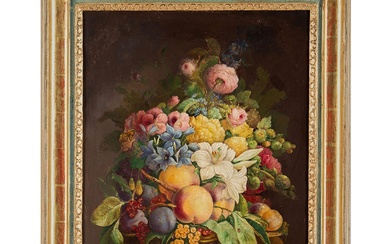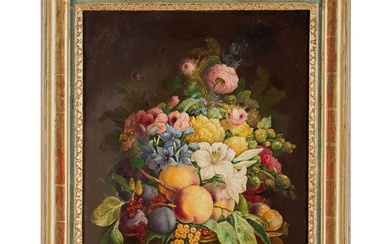Still Life
PROPERTY OF A MUMBAI LADY
Oil on canvas
1948
15 7/8 x 13 7/8 in. (40.2 x 35.3 cm.)
Faintly inscribed '1948 / STILL-LIFE / NOT FOR SALE / JEHANGIR SABAVALA' on an exhibition label on reverse
Jehangir Sabavala’s early works are closely linked to his academic training and the years he spent in London and Paris as a young man. Having completed his diploma at the Sir J.J. School of Art in 1944, he decided to further enroll in art school at the Heatherley School of Art in London from 1945-1 947, followed by a period of four important years in Paris, first at the Académie Julian and then at the Académie André Lhote. Each of these institutions, coupled with the teachers, students and artists he met, exposed him to various facets of European Modernism. Whilst his time in London taught him the rigours of British academic techniques and naturalism, his time at the Académie Julian introduced him to the Impressionist movement, and his time with André Lhote taught him the tenets of Cubism, that would become an integral part of his technique in the years that followed. On a separate note, it was also during this period that he met and developed a close relationship with Shirin Dastur, whom he would marry in 1948, the year the current Still Life was painted.
Painted during these early years, the subject, technique and stylistic elements of the current work, are very much a product of Sabavala’s training at these European art schools, as it combines the principles of Academism with the individualism of Impressionism. The dark background of the work is in sharp contrast to the riotous mass of flowers in lighter tones that emerge from the vase. Unlike works in a similar vein that would immediately follow, the current work is a testament to his academic training; a forerunner of sorts, before he begins to modify his learnings to include personal concerns that eventually see the emergence of his own painterly identity.
‘The Sabavala of the early 1950s was still coming to terms with himself qua painter; here was a temperament learning to acknowledge that its dreams were far more than a passing diversion. By upbringing and training, Sabavala was (in Baudelaire’s phrase) a free-wheeling, inventive “kaleidoscope equipped with consciousness”, designed to record and re-interpret every fleeting sensation and magnificent phenomenon. But would he permit his personality to dominate his expression, content himself with a dilettante’s pleasant existence? Or would he accept the formal restraint of method, then master it and become a technical virtuoso; or would he integrate the two alternatives in a more harmonic unity?’ (Ranjit Hoskote, Pilgrim, Exile, Sorcerer The Painterly Evolution of Jehangir Sabavala, Mumbai, 1998, p. 55)
The artist has authenticated the work in 2007.
Condition: The colours of the original are slightly brighter and the brown areas in the right third of the painting are less orange and more yellow in tone. Craquelure visible along the lower left edge and a few scattered areas within the flowers. When examined under UV light, several small spots areas of consolidation and retouching are visible with a slightly larger area below the flower at the extreme right, and two smaller areas in the central portion of the painting. An approximately 1 x 1 cm. patch of previous repair visible on the reverse. The painting has been recently cleaned and varnished. Overall good condition.
View it on
Sale price
Estimate
Reserve
Time, Location
Auction House
PROPERTY OF A MUMBAI LADY
Oil on canvas
1948
15 7/8 x 13 7/8 in. (40.2 x 35.3 cm.)
Faintly inscribed '1948 / STILL-LIFE / NOT FOR SALE / JEHANGIR SABAVALA' on an exhibition label on reverse
Jehangir Sabavala’s early works are closely linked to his academic training and the years he spent in London and Paris as a young man. Having completed his diploma at the Sir J.J. School of Art in 1944, he decided to further enroll in art school at the Heatherley School of Art in London from 1945-1 947, followed by a period of four important years in Paris, first at the Académie Julian and then at the Académie André Lhote. Each of these institutions, coupled with the teachers, students and artists he met, exposed him to various facets of European Modernism. Whilst his time in London taught him the rigours of British academic techniques and naturalism, his time at the Académie Julian introduced him to the Impressionist movement, and his time with André Lhote taught him the tenets of Cubism, that would become an integral part of his technique in the years that followed. On a separate note, it was also during this period that he met and developed a close relationship with Shirin Dastur, whom he would marry in 1948, the year the current Still Life was painted.
Painted during these early years, the subject, technique and stylistic elements of the current work, are very much a product of Sabavala’s training at these European art schools, as it combines the principles of Academism with the individualism of Impressionism. The dark background of the work is in sharp contrast to the riotous mass of flowers in lighter tones that emerge from the vase. Unlike works in a similar vein that would immediately follow, the current work is a testament to his academic training; a forerunner of sorts, before he begins to modify his learnings to include personal concerns that eventually see the emergence of his own painterly identity.
‘The Sabavala of the early 1950s was still coming to terms with himself qua painter; here was a temperament learning to acknowledge that its dreams were far more than a passing diversion. By upbringing and training, Sabavala was (in Baudelaire’s phrase) a free-wheeling, inventive “kaleidoscope equipped with consciousness”, designed to record and re-interpret every fleeting sensation and magnificent phenomenon. But would he permit his personality to dominate his expression, content himself with a dilettante’s pleasant existence? Or would he accept the formal restraint of method, then master it and become a technical virtuoso; or would he integrate the two alternatives in a more harmonic unity?’ (Ranjit Hoskote, Pilgrim, Exile, Sorcerer The Painterly Evolution of Jehangir Sabavala, Mumbai, 1998, p. 55)
The artist has authenticated the work in 2007.
Condition: The colours of the original are slightly brighter and the brown areas in the right third of the painting are less orange and more yellow in tone. Craquelure visible along the lower left edge and a few scattered areas within the flowers. When examined under UV light, several small spots areas of consolidation and retouching are visible with a slightly larger area below the flower at the extreme right, and two smaller areas in the central portion of the painting. An approximately 1 x 1 cm. patch of previous repair visible on the reverse. The painting has been recently cleaned and varnished. Overall good condition.







